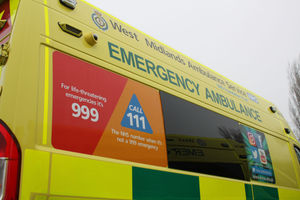Callers to 999 are being told to seek their treatment elsewhere
Successful trials in the West Midlands of a new method of screening ambulance calls will see England’s public told to seek alternative treatment unless their condition is life-threatening.

NHS England wants calls reviewed so those concerning non-life-threatening conditions – referred to under category two, which includes emergencies such as heart attacks and strokes but also burns and severe headaches – are referred instead to an urgent treatment clinic, a GP or a pharmacist.
Some 40 per cent of calls classed as category two will now receive callbacks from a doctor, nurse or paramedic to investigate the possibility of an ambulance alternative.
Nearly half of those who received callbacks in trials in the West Midlands as well as London were advised to seek alternative treatment to an ambulance.
NHS England will now ask the country’s eight other ambulance services to adopt the approach.
Ambulance trusts across the country are struggling to respond to 999 calls on time, with delays handing patients to A&E playing a major role.
Professor Julian Redhead, NHS England national clinical director for urgent and emergency care, said: “This new system will allow a conversation between a nurse and paramedic or a doctor and the patient - and between them, they’ll be able to decide whether an ambulance is the best response or whether no ambulance is required and they’re better cared for in a different environment.
“It’s really important that people know it doesn’t mean anyone loses their place in the queue (while they are assessed).
“What it does is provide more individualised care for a patient but also allows us to free up the resource for our most vulnerable patients, patients who will have had strokes and heart attacks.”
Following trials within West Midlands Ambulance Service, NHS England expects all ambulance services to move to the new system in the next couple of weeks, with it kept under review.
The new system aims to alleviate pressure on ambulance services, which fell into crisis in December.
The average response time in December for ambulances dealing with the most urgent incidents, such as cardiac arrests, was 10 minutes and 57 seconds. Set against a target of seven minutes, it was the worst performance on record.
For category two calls, ambulances took an average of one hour, 32 minutes and 54 seconds to respond. That was the longest on record and well above the target of 18 minutes.
The delays came as ambulances were forced to queue outside hospitals to drop off patients because of crowding in emergency units and a lack of beds. Figures for January have shown an improvement in all ambulance response times.
The new trial comes as ambulance workers in England continue industrial action in the long-running dispute over pay and staffing, with no sign of a breakthrough in the increasingly bitter row.
About 15,000 members of Unison in five areas walked out last Friday, with officials warning of escalating action in the coming weeks unless the deadlock is broken. Unite said more than 1,000 workers employed by the South Central, South East Coast and Yorkshire ambulance services had voted to join the NHS strikes. They will oin around 2,800 colleagues already striking, including those in the West Midlands, East Midlands, North West, North East and Wales already striking over pay.




